A Fermentor is a device used to accomplish the fermentation process by using microorganisms, and for this reason, it is also called “Biofermentor or Bioreactor“. It is equipped with all the elements that are necessary to carry out the commercial production of substances like antibiotics, enzymes, beverages etc. in many industries.
Fermentor is designed in such a way that a higher value of product could form by the microorganisms by utilizing a small amount of media. It shows broad applicability in the food industry, wastewater treatment etc. Fermentation is the bioprocessing of the raw substrates through microbial biomass (mostly yeasts and bacteria).
The process is either carried out in a liquid substrate or anaerobic solids by utilizing which the microorganisms form a large quantity of desired metabolites. The fermented product can be collected from the bioreactor either at regular intervals (batch fermentation) or ongoing (continuous fermentation).
In this context, we will discuss several contributions that led to the discovery of the fermentor along with the purpose, ideal properties, construction and different types of fermentors.
Content: Fermentor
Definition of Fermentor
A Fermentor can define as a closed cylindrical vessel which supports the biochemical and chemical activity of the microorganisms to carry the conversion of raw material into some useful product. It is also called a bioreactor, as it makes the use of microbial biomass to accomplish the fermentation process. Depending upon the use of stock culture, a fermentation process is subdivided into surface and submersion techniques. In surface fermentation, the biomass is cultivated on the surface of the raw substrate, while the microorganisms grow in the raw substrate during submersion fermentation.
History
There is a table given below that will help us to know the contributions that led to the discovery of fermentor.
| Year of discovery | Name of the discoverer and their discovery |
|---|---|
| During 1914-15 | A fermentor was developed for the production of acetone by the scientist Chain Weizmann. |
| 1930 | Large scale aerobic fermentor was developed. |
| 1934 | In this year, aeration system, water and steam inlet flow was introduced in a fermentor by the scientists Strauch and Schmidt. |
| 1944 | A fermentor was developed for the yeast production by the scientists De Beeze and Liebmann for the large scale production. |
| 1950 | A fermentor was developed in India at Hindustan Antibiotic Ltd., Pune and named it as “Pilot fermentor”. |
Objectives of Fermentor
The objectives include the production of metabolites, enzymes, microbial biomass and recombinant product.
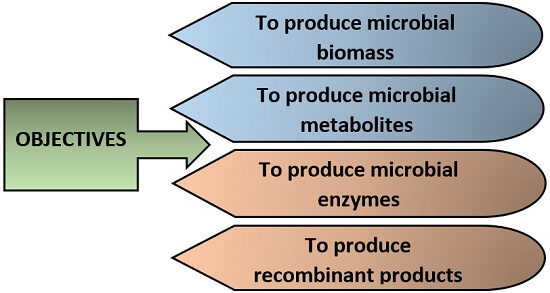
Ideal Properties of a fermentor
- A fermentor should be made of a good quality material that can withstand all the conditions inside the vessel.
- It should give high productivity.
- It should be able to handle the stream sterilization pressure.
- There should be all the control parameters to monitor the fermentation process like pH electrode, temperature probe etc.
- A material used in the fermentor should be cheap that could give satisfactory results.
Design of Fermentor
The construction of fermentor includes the following components:
- Basic elements
- Controlling elements
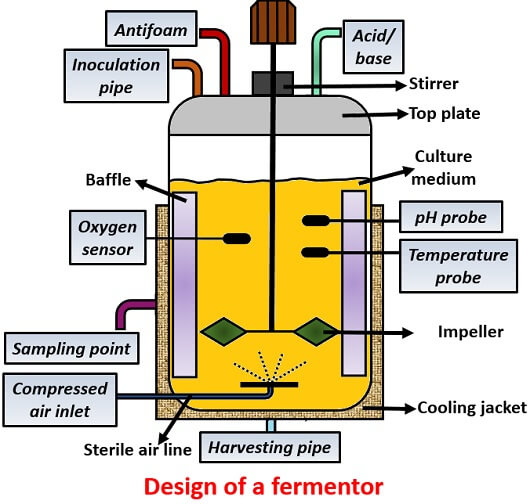
Basic Elements
Basic components are necessary for the construction of fermentor, which involves:
Top-plate: It is the cover that is generally made of stainless steel.
Inoculation pipe: It helps to port the inoculum inside the fermentor.
Drive motor: It drives the impeller shaft.
Impeller shaft: Holds the agitator centrally.
Impeller: Acts as an agitating device for mixing up the nutrients and microorganisms uniformly.
Stirrer: Mixes the gas bubbles throughout the liquid culture medium.
Baffle: Prevents the counterflow or vortex formation by breaking down the gas bubbles to improve aeration efficiency.
Sparger: It supplies oxygen into the culture medium through the perforated tubes.
Drain point: Withdraws cells or medium for the continuous fermentation.
Cooling jacket: It is fitted externally to the fermentation vessel which allows the passage of steam or cold water to balance the heat generated during the process.
Controlling Elements
Controlling elements monitor the parameters like (temperature, pH, acid, bases, oxygen supply, pressure etc.) that are necessary for the product formation and it includes:
Pt-100: Monitors the temperature in the culture vessel.
Foam probe: It senses foam formation.
pH electrode: Monitors the pH in the culture vessel.
Oxygen sensor: Maintains the dissolved oxygen content level.
Heating pad: Provides heat to the medium.
Cold finger: It is a pipe that passes cold water inside a vessel to cool the contents.
Rotameter: Provides variable airflow into the culture vessel.
Pressure valve: Maintains the pressure.
Air pump: Supplies air throughout the medium.
Peristaltic pump: It pumps acid, base and antifoam into the medium.
Properties of a Fermentor
- It should be reliable for long-term operation.
- A fermentor should be capable of being operated aseptically or should provide sterile conditions.
- The bioreactor provides adequate aeration and agitation for uniform mixing of the contents in the vessel.
- It should consume less power.
- A fermentor must be equipped with controlling probes that can maintain the temperature, pH, oxygen level etc.
- It facilitates the passage of inoculum and media into the vessel.
- A bioreactor does not allow excessive evaporation loss.
- It minimizes the labour input for the operation, harvesting, cleaning and maintenance.
Types of Fermentor
A fermentor is mainly of five types:
- Stirred tank fermentor
- Airlift fermentor
- Fluidised bed fermentor
- Packed bed fermentor
- Photo fermentor
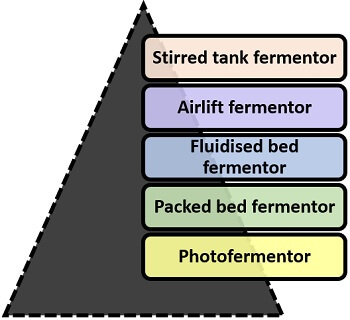
Stirred Tank Fermentor
It consists of the motor driveshaft and a variable number of impellers (more than one). The impellers have a 1/3rd diameter of the vessel. The height and diameter ratio of this bioreactor is between 3:5. Air passes into the culture medium through a single orifice from the tube attached externally. It enables better distribution of the contents throughout the vessel. Its basic functions include:
- Homogenization
- Suspension of solid material
- Aeration to the medium
- Heat exchange
In stirred tank fermentor, rotating stirrer and baffle are found either at the top or the bottom. It mainly uses the batch process of fermentation.
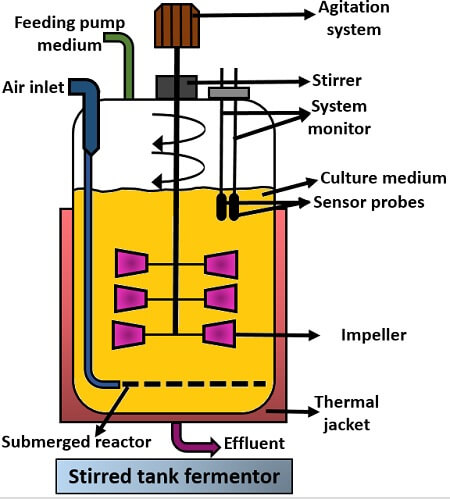
Advantages
- It is easy to operate and easy to clean.
- Provides a good temperature control.
- The construction of stirred tank fermentor is quite simple.
- It has a low operating cost.
- It does not cause shear damage to the cells.
Disadvantages
- It cannot be used for immobilized cells or enzymes.
- It has low volumetric productivity.
Airlift Fermentor
It consists of a single container inside which a hollow tube is present. This hollow tube called “Draft tube”. There is a gas flow inlet present at the bottom of the fermentor, which allows the passage of oxygen. Gas flow inlet is attached with the perforated disc or tube that allows continuous distribution of air.
This type of bioreactor lacks the mechanical stirring arrangements for agitation. As from the name airlift, it is clear that the air lifts the medium upwards. There are internal liquid circulation channels, which enable continuous circulatory motion of the medium. Here, the fermentation occurs at a fixed rate of volume and circulation.
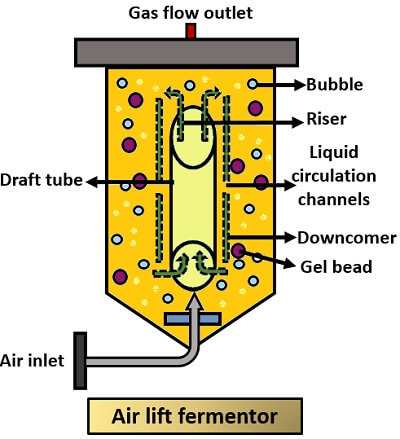
Advantages
- It ensures adequate mixing.
- Consumes less energy.
- It favours the growth of aerobic cultures.
- Construction is simple.
- It can use both free and immobilized cells and enzymes.
- Widely used in SCP production.
- Avoids excessive heat generation.
Disadvantages
- Lacks mechanical stirring arrangements.
Fluidized Bed Fermentor
The top portion of this bioreactor is more expanded. This expansion reduces the velocity of the fluid. Its bottom part is slightly narrow. It is designed in such a way where:
- The solid retain inside the vessel.
- And, liquid flows out.
An adequate amount of gas introduces into the medium to form a suitable gas-liquid-solid fluidised bed. By using this kind of biofermentor one should note that the suspended particles should not be too light or too heavy and secondly, there should be continuous recycling of the medium for good bioprocessing.
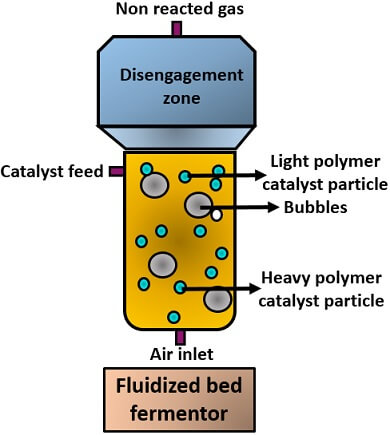
Advantages
- Mixes the contents uniformly.
- Maintains the uniform temperature gradient.
- It can be used for continuous operation.
- Produces higher volumetric productivity.
- There is little or no clogging of particles.
Packed Bed Fermentor
It consists of a cylindrical vessel and a packed bed with biocatalysts. The solid matrix that is used for the packed bed fermentor possess the following properties:
- Porous or non-porous
- Highly compressible
- Rigid
In this kind of biofermentor, a nutrient broth continuously flows over the immobilized biocatalyst. After that, a product releases into the fluid at the bottom of the culture vessel and finally, it can be removed. Here, the flow of fluid can be upward or downward.
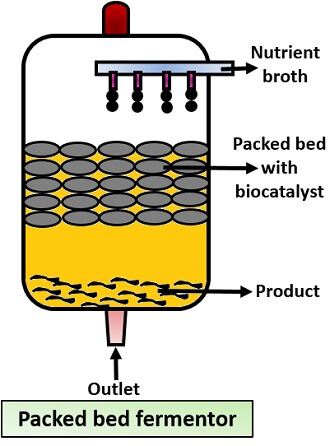
Advantages
- It has a low operation cost.
- Provides continuous operation.
- Separation of the biocatalyst is easy.
- It is widely used in wastewater engineering.
Disadvantages
- There are undesired heat gradients.
- Poor temperature control.
- There is an alternation in the bed porosity.
- Involves higher risk of particles clogging.
Photo Fermentor
This fermentor works under the principle of light energy that involves direct exposure to the sunlight or through some artificial illumination. It is extensively used for the production of p-Carotene, astaxanthin etc. This type of bioreactor is basically made of glass or plastic. Photo fermentor consists of:
- A single container
- Number of tubes or panels
Tubes act as “Solar light receivers or trappers”. In this, culture transfers through solar trappers with the help of a centrifugal pump. Inside photo fermentor, adequate penetration of sunlight is maintained and after that, it is cooled when there is a rise in temperature. Here, the microalgae and cyanobacteria are the common microorganisms that are used. These microorganisms grow in the presence of solar light and then product forms during the night.
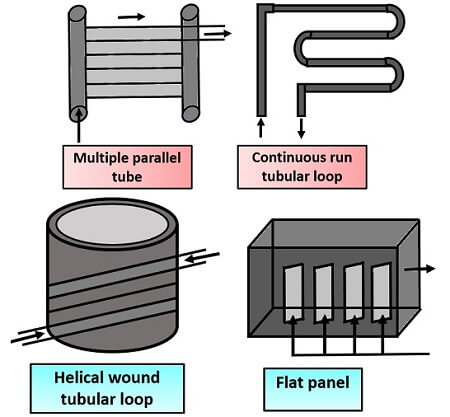
Advantages
- It gives higher productivity.
- Provides a large surface and volume ratio.
- Provides better control over the gas transfer.
- Maintains uniform temperature gradient.
Disadvantages
- Expensive method to carry out.
- There is a technical difficulty in the process of sterilization.
Conclusion
A bioreactor or fermentor means bio: living organisms and reactor: which gives energy. Therefore, we can conclude that fermentor is the culture vessel where the microorganisms utilize all the nutrients under optimum conditions inside a bioreactor into desirable products. It performs bioconversion or modification of a compound into a biological and biochemical compound like antibiotics, enzymes, SCPs etc.
Thanks for the information. can i get your references for every type of the fermentor?